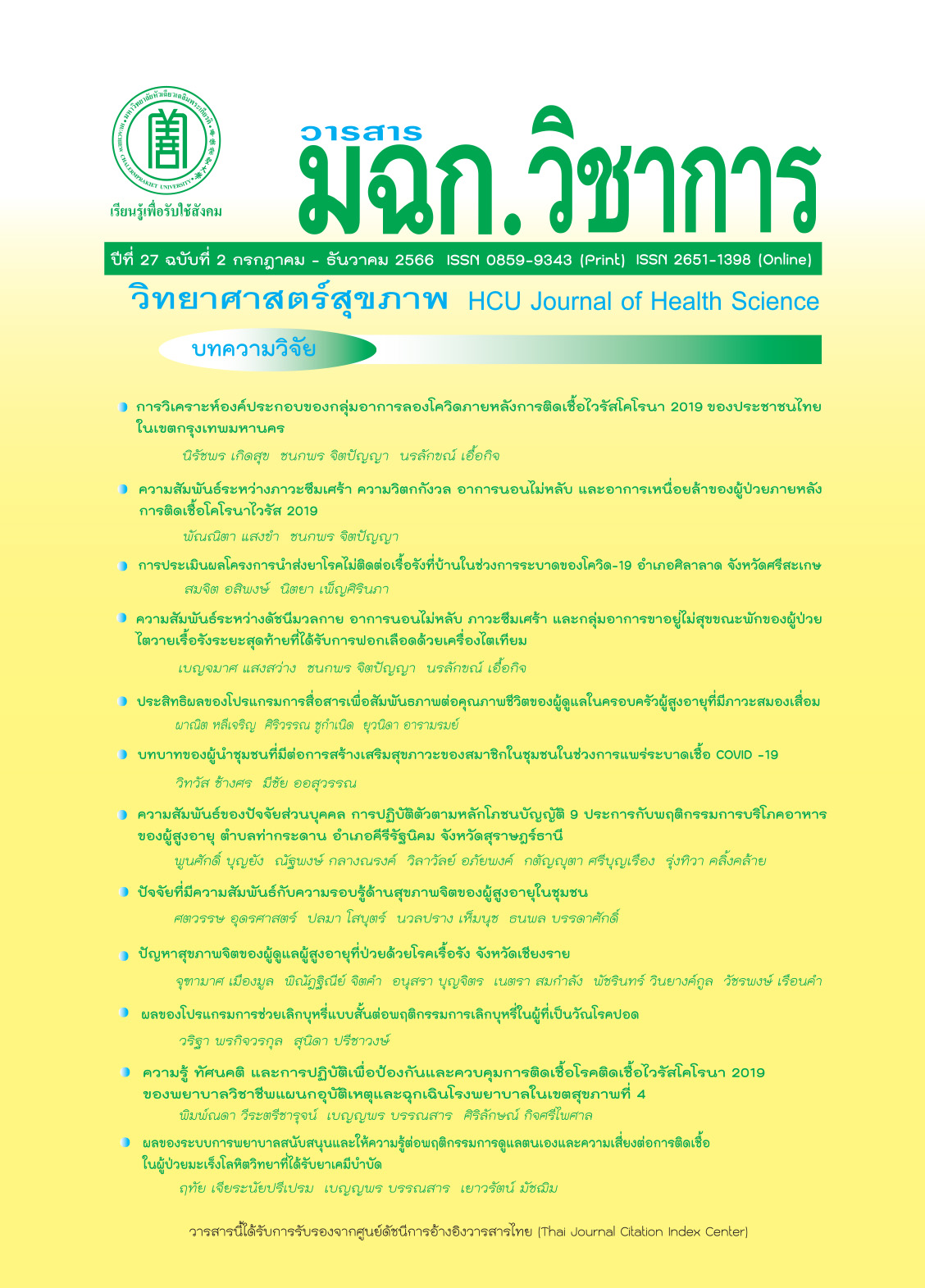ความสัมพันธ์ระหว่างภาวะซึมเศร้า ความวิตกกังวล อาการนอนไม่หลับ และอาการเหนื่อยล้าของผู้ป่วยภายหลังการติดเชื้อโคโรนาไวรัส 2019
คำสำคัญ:
ภาวะซึมเศร้า, ความวิตกกังวล, อาการนอนไม่หลับ, อาการเหนื่อยล้า, โคโรนาไวรัส 2019บทคัดย่อ
การวิจัยนี้เป็นการวิจัยเชิงบรรยาย มีวัตถุประสงค์เพื่อศึกษาอาการเหนื่อยล้าของผู้ป่วยภายหลังการติดเชื้อโคโรนาไวรัส 2019และศึกษาความสัมพันธ์ระหว่างภาวะซึมเศร้า ความวิตกกังวล อาการนอนไม่หลับ และอาการเหนื่อยล้าของผู้ป่วยภายหลังการติดเชื้อโคโรนาไวรัส 2019 กลุ่มตัวอย่างคือ คนไทยภายหลังการติดเชื้อโคโรนาไวรัส อายุตั้งแต่ 18 ปีขึ้นไปที่อาศัยอยู่ในชุมชนคลองเตย กรุงเทพมหานคร จำนวน 101 คน เครื่องมือที่ใช้ในการเก็บรวบรวมข้อมูล ประกอบด้วย แบบบันทึกข้อมูลส่วนบุคคลและการเจ็บป่วย แบบประเมินภาวะสุขภาพจิต แบบสอบถามอาการนอนไม่หลับ และแบบประเมินอาการเหนื่อยล้า วิเคราะห์ข้อมูลโดยการแจกแจงความถี่ ร้อยละ พิสัย ค่าเฉลี่ย ส่วนเบี่ยงเบนมาตรฐาน และค่าสัมประสิทธิ์สหสัมพันธ์ของเพียร์สัน ผลการวิจัยพบว่าร้อยละ 79.2 ของกลุ่มตัวอย่างเป็นเพศหญิง อายุเฉลี่ย 55.08 ปี (SD=15.048) และร้อยละ 89.1ของกลุ่มตัวอย่างติดเชื้อ COVID 19 จำนวน 1 ครั้ง ร้อยละ 40.6 ของกลุ่มตัวอย่างรายงานว่ามีอาการเหนื่อยล้า (Means=3.40, SD=2.03) และร้อยละ 58.4 มีอาการนอนไม่หลับ (Means=9.79, SD=7.935) กลุ่มตัวอย่างส่วนใหญ่มีคะแนนภาวะซึมเศร้าและความวิตกกังวลอยู่ในระดับปกติ ภาวะซึมเศร้า ความวิตกกังวล และอาการนอนไม่หลับมีความสัมพันธ์กับอาการเหนื่อยล้าอย่างมีนัยสำคัญทางสถิติ (r=0.526, p<0.001, r=0.558, p<0.001 และ r=0.443, p<0.001 ตามลำดับ)
จากผลการศึกษา พยาบาลควรมีการติดตามอาการเหนื่อยล้าของผู้ป่วยภายหลังการติดเชื้อโคโรนาไวรัส 2019 ร่วมกับประเมินภาวะซึมเศร้า ความวิตกกังวล และอาการนอนไม่หลับ นอกจากนี้ควรให้การพยาบาลโดยการให้ความรู้ ใช้กระบวนการกลุ่ม รวมทั้งปฏิบัติการพยาบาลเพื่อส่งเสริมการนอนหลับแก่ผู้ป่วย
Downloads
References
WHO. COVID-19 Weekly Epidemiological Update [internet]. 2022 [cited 2022 February 10]. Available from:https://www.who.int/publications/m/item/weekly-epidemiological-update-on-covid-19---11-january-2022.
Department of Disease Control. Situation of COVID 19 : daily update [internet]. 2022 [cited 2022 February 10]. Available from: https://ddc.moph.go.th/covid19-dashboard/. (in Thai)
Department of Disease Control. Situation of Coronavirus 2019 (COVID-19), Health measure, problems and obstacles to disease control of tourism [internet]. 2022 [cited 2022 February 10]. Available from: https://ddc.moph.go.th/uploads/files/2017420210820025238.pdf. (in Thai)
Klinkhajon U, Worramalee S, Yajai S. Role of nurses in caring for coronavirus (COVID-19) patients: a case study. RTNNMDjournal. 2020;47(3):703-721. (in Thai)
Department of Medical Service. Post COVID syndrome or long COVID: health care worker [internet]. 2021 [cited 2022 February 10]. Available from: https://covid19.dms.go.th/backen d/Content/Content_File/Covid_Health/Attach/25650126100932AM_%E0%B8%81%E0%B8%B2%E0%B8%A3%E0%B8%94%E0%B8%B9%E0%B9%81%E0%B8%A5%E0%B8%A3%E0%B8%B1%E0%B8%81%E0%B8%A9%E0%B8%B2%E0%B8%9C%E0%B8%B9%E0%B9%89%E0%B8%9B%E0%B9%88%E0%B8%A7%E0%B8%A2%20Long%20COVID%20v.2.4.pdf. (in Thai)
Lopez-Leon S, Wegman-Ostrosky T, Perelman C, Sepulveda R, Rebolledo PA, Cuapio A, et al. More than 50 long-term effects of COVID-19: a systematic review and meta-analysis. Scientific report. 2021;11(1):1-12.
Crook H, Raza S, Nowell J, Young M, Edison P. Long covid-mechanisms, risk factors, and management. BMJ. 2021;374:1-18.
Mackay A. A Paradigm for post-Covid-19 fatigue syndrome analogous to ME/CFS. Frontiers in Neurology 2021;12:1-10.
Carod-Artal FJ, García-Moncó JC. Epidemiology, pathophysiology, and classification of the neurological symptoms of post-COVID-19 syndrome. Neurology Perspectives 2021;1:5-15.
Sandler CX, Wyller VBB, Moss-Morris R, Buchwald D, Crawley E, Hautvast J, et al. Long COVID and post-infective fatigue syndrome: a review. Open Forum Infection Disease 2021;8(10),1-7.
Ream E, Richardson A. From theory to practice: designing intervention to reduce fatigue in patient with cancer. Oncology Nursing Forum 1999;14(6):25-30.
Rudroff T, Fietsam AC, Deters JR, Bryant AD, Kamholz J. Post-COVID-19 fatigue: potential contributing factors. Brain Science 2020;10(12),1-7.
Hartung TJ, Neumann C, Bahmer T, Chaplinskaya-Sobol I, Endres M, Geritz J, et al. Fatigue and cognitive impairment after COVID-19: a prospective multicentre study. EClinicalMedicine 2022;53:1-13.
Careplus International Clinics. How to cure sleep distribution post covid. 2022 [cited 2022 February 23]. Available from: https://careplusvn.com/en/how-to-cure-sleep-distribution-post-covid
Piper BF. Fatigue and cancer inevitable companions. Supportive Care in Cancer 1993;1(6):285-6.
Sanitlou N, Sartphet W, Naphaarrak Y. Sample size calculation using G*. J of Suvarnabhumi Tech. 2019;5(1):498-507. (in Thai)
Kaewkungwal J, Singhasivanon T. Textbook of clinical research. Bangkok: Faculty of Tropical Medicine, Mahidol University; 2013. (in Thai)
Oei TP, Sawang S, Goh YW, Mukhtar F. Using the depression anxiety stress scale 21 (DASS-21) across cultures. Int J Psychol. 2013;48(6):1018-29.
Morin CM. Insomnia: Psychological assessment and management. New York: Guilford Press; 1993.
Keawphang P. Relationships between selected factors and insomnia in adult cancer patients [Dissertation]. Bangkok: Chulalongkorn University; 2004. (in Thai)
Krupp LB, LaRocca NG, Muir-Nash J, Steinberg AD. The fatigue severity scale. Application to patients with multiple sclerosis and systemic lupus erythematosus. Archives of Neurology. 1989;46(10):1121-3.
Sawasdee A. Factors associated with fatigue in post stroke patient [Dissertation]. Bangkok: Chulalongkorn University; 2014. (in Thai)
Michael K. Fatigue and stroke. Rehabilitation Nursing. 2002;27(3):89-94.
Noujaim PJ, Jolly D, Coutureau C, Kanagaratnam L. Fatigue and quality-of-life in the year following SARS-Cov2 infection. BMC Infectious Diseases. 2022;22(1):541.
Diem L, Fregolente-Gomes L, Warncke JD, Hammer H, Friedli C, Kamber N, et al. Fatigue in post-COVID-19 syndrome: clinical phenomenology, comorbidities and association with initial course of COVID-19. J Cent Nerv Sys Dis. 2022;14:1-7.
Benjapolpitak A, Sawangtham T, Chakkraphan na Ayutthata A, Kemphet R, Wiangcharoen R, Kanlayanaphotporn J, et al. Mental health effect of Coronavirus outbreak (COVID-19) in health region5Thailand. [internet]. 2022 [cited 2022 February 10]. Available from: https://kb.hsri.or.th/dspace/bitstream/handle/11228/5481/hs2747.pdf?sequence=3&isAllowed=y. (in Thai)
Chuatrakul P, Panuthai S, Kampolsiri T. Fatigue among older patients with colorectal cancer receiving chemotherapy and related factors. Nursing Journal. 2013;40(3):62-74. (in Thai)
Grover S, Sahoo S, Mishra E, Gill KS, Mehra A, Nehra R, et al. Fatigue, perceived stigma, self-reported cognitive deficits and psychological morbidity in patients recovered from COVID-19 infection. Asian Journal of Psychiatry. 2021;64:1-8.
Orendacova M, Kvasnak E, Vranova J. Effect of neurofeedback therapy on neurological post-COVID-19 complications (a pilot study). PLoS One. 2021;17(7):1-21.
Poovorawan Y. COVID 19 and epidemiology. [internet]. 2021 [cited 2023 February 22]. Available from: https://learningcovid.ku.ac.th/course/?c=7&l=2
Hartung TJ, Neumann C, Bahmer T, Chaplinskaya-Sobol I, Endres M, Geritz J, et al. Fatigue and cognitive impairment after COVID-19: A prospective multicentre study. EClinical Medicine 2022;53:1-13.
Lingthaisong C, Yeesri S, Nakrat K, Cheewakiatyingyong T. The study impacts post Coronavirus disease 2019 (COVID-19) of personal, Metropolitan Health and Wellness Instutution [internet]. 2021 [cited 2023 February 22]. Available from: https://doi.org/10.1016/j.ijtb.2021.06.012 (in Thai)
Sharma P, Bharti S, Garg I. Post COVID fatigue: Can we really ignore it? [internet]. 2021 [cited 2022 February 10]. Available from: https://doi.org/10.1016/j.ijtb.2021.06.012
Gupta R, Pandi-Perumal SR. SARS-CoV-2 infection: paving way for sleep disorders in long term. Sleep Vigil. 2021;5(1):1-2.
Badinlou F, Lundgren T, Jansson-Fröjmark M. Mental health outcomes following COVID-19 infection: impacts of post-COVID impairments and fatigue on depression, anxiety, and insomnia. Research Square. 2022;22(1):1-24.
Downloads
เผยแพร่แล้ว
How to Cite
ฉบับ
บท
License
Copyright (c) 2023 วารสาร มฉก.วิชาการ

This work is licensed under a Creative Commons Attribution-NonCommercial-NoDerivatives 4.0 International License.
บทความที่ได้รับการตีพิมพ์เป็นลิขสิทธิ์ของวารสารวิทยาศาสตร์สุขภาพและสุขภาวะ
ข้อความที่ปรากฏในบทความแต่ละเรื่องในวารสารวิชาการเล่มนี้เป็นความคิดเห็นส่วนตัวของผู้เขียนแต่ละท่านไม่เกี่ยวข้องกับมหาวิทยาลัยหัวเฉียวเฉลิมพระเกียรติ และคณาจารย์ท่านอื่นๆในมหาวิทยาลัยฯ แต่อย่างใด ความรับผิดชอบองค์ประกอบทั้งหมดของบทความแต่ละเรื่องเป็นของผู้เขียนแต่ละท่าน หากมีความผิดพลาดใดๆ ผู้เขียนแต่ละท่านจะรับผิดชอบบทความของตนเองแต่ผู้เดียว



